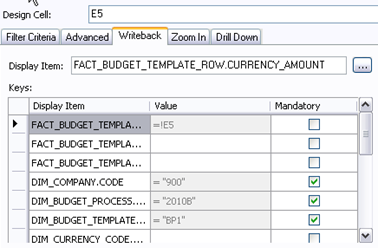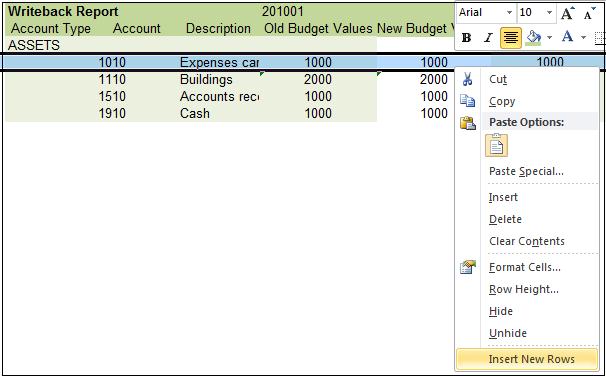Writeback —Exercises
| IMPORTANT |
| The exercise scenarios in this document uses data from the RACE version
of the database released with App75 SP4 as example data. |
Creating the Writeback design
Purpose: The purpose of this exercise is to show you how
to create a report that will allow you to writeback information into IFS
Application from End User mode.
Scenario: For this exercise Budget Template Transaction will be
used as the information Source, 2010B as the Budget Process ID and
RACEX as the Budget Template (X can be any number from 1-9) .
Windows:
IFS Business Analytics/Design Mode
- Click Go to Design.
-
Select Budget Template Transaction information source.
- Create a design row for row 4 and 5 and drag Account type and
Account from Account dimension to Repeater tab.
Refer to the image below:

- Select the Filter Criteria tab and drag Account Type
where Account Type = 'COST'.
- Click Sheet .
- Select the Filter Criteria tab and drag the display items
where Budget template ID = 'RACE(X)' , Budget Process ID = '2010B' and
Company = '900'. Refer to the image below:

- Drag Account Type to cell A4, Account to cell B5 and
Account Description to cell C5.
- Drag Currency Amount to cell D5 and E5. The Currency Amount in E5
will be used to writeback information.
- Drag Account Period as the display item to cell D2.
- Create a design column for column D and E and repeat them using
Accounting Period.
- Add headings to row 3 and format the design row with colors and importantly
use a different color for cell E5 as this will be
used as the writeback cell. In the image below the cell represented by the
color white indicates that this cell should be updated and used for
writeback.

- Highlight cell E5.
- Select the Writeback tab, click the list of values from Display Items and select Currency Amount from
Measure Items.

- Mandatory fields will be automatically filled based on the filter
criteria's and repeater's entered in the previous steps.
- Click Execute. Refer to the image below:

Perform Complete Writeback
Purpose: The purpose of this exercise is to writeback all
the values in column E.
Scenario: In this
exercise values will be changed for a particular column in the report and the
resulting data set will be written back entirely to IFS Applications.
Windows:
IFS Business Analytics/End User Mode/Writeback
- Change the values in column E as shown in the figure below:

- Click Writeback from the Document Action Pane.
- Click Collect Data Sets. The resulting data set should be similar
to the image below regardless of the amount in column E been changed. Refer
to the image below:

- Click Collective Writeback to update the values directly
to IFS Applications.
- Login to IFS Applications and verify the updated values in Budget Process
(Open the
Budget Template window and query for your Budget
Template) .
Perform Modified Writeback
Purpose: The purpose of this exercise is to only writeback
modified data sets.
Windows:
IFS Business Analytics/End User Mode/Writeback
- Go back to Design Mode
- Click Report Book and click Options.
- Select Allowed Modified Writeback from the Options pane.
- Select Allow Comparison with Database Values from Options
pane, if you want to compare writeback values with current database values.
- Click Execute. Click the option Fresh Data in order to receive
updated data from IFS Applications.
- Change one of the values in column E.
- Click Writeback and then click Collect modified Data Sets
in the Writeback pane.
Note: The resulting data set should be
only the rows that you have changed.
- Refer to the value in Currency Amount
(Original) column and the new value in Currency Amount (Current)
column
to compare new value and database value.
- The check box at the start of the collected row
will be selected for writeback by default.
- Click Collective Writeback to update the budget values directly
to IFS Applications.
- Go to IFS Applications and verify the updated values in Budget Process.
Perform Writeback with Null and Zero values
Purpose: The purpose of this lesson is writeback null and
zero values.
Windows:
IFS Business Analytics/Go to Design/Writeback
- Go back to Design Mode
- Click Report Book and click Options
and select Writeback Zero Values and Writeback NULL Values.
- Click Execute. Click the option Fresh Data in order to receive
updated data from IFS Applications.
- In the executed report change one of the values in column E to 0 and
another to null (blank).
- Click Writeback and then click Collect Modified Data Sets.
Null and Zero values should be displayed as the resulting data set for the
rows.
- Click Collective Writeback to update the budget values directly
to IFS Applications.
- Go to IFS Applications and verify the updated values in the Budget Process.
Inserting new values for writeback
Purpose: The purpose of this exercise is to insert new values to a writeback report and perform writeback.
Windows:
IFS Business Analytics/Go to Design/ Advanced Repeater Settings
IFS Business Analytics /End User Mode / Right-click on a row or column /Insert new values for Writeback
- Go back to Design Mode.
- Select DIM_ACCOUNT.CODE repeater level, select Advanced Settigs button and select Enable Insert of New values for Writeback check box.
- Execute the report.
- Select a row with Account values,right-click and select Insert New Row.


- In the Inset New Values for Writeback window fill a value for Account as 1011 and click OK.
- Report will be re- executed and the account will be inserted into the report as below.

- Perform a complete or modified writeback.














